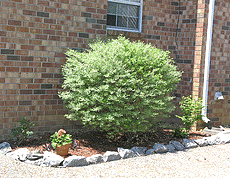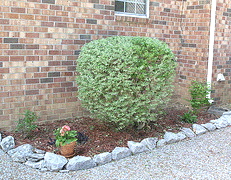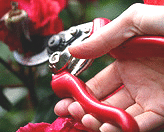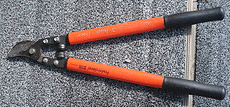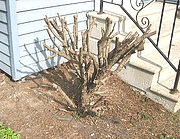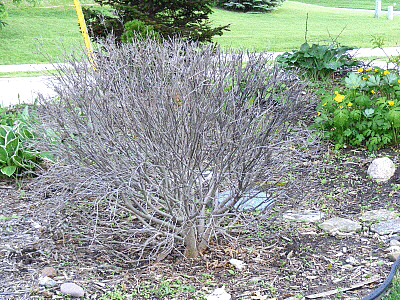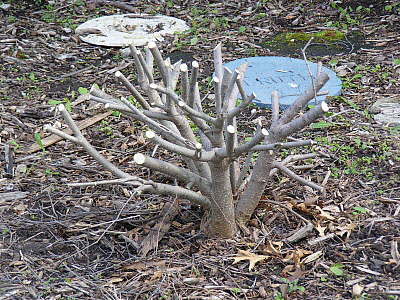Shrubs will need to be pruned periodically to maintain or improve the plants health, form, and fruit or flower production
Don’t feel that you need to prune just because you “should”. This shrub in its’ natural form is perhaps more appealing than after being trimmed. You need to do what you like
There is a lot of information involved in pruning shrubs, but the basics are really quite simple. When you take it one plant type at a time and think about why you are pruning it, it’s hard to make too many mistakes. And mistakes will heal themselves, so don’t worry about ruining your bush. Any pruning will generally benefit a shrub even if you don’t do it “right”.
Starting simply, you need to prune for one or more of the following reasons:
Remove all dead, diseased, broken and weak branches to insects and disease don’t enter the plant.
Reduce the size of a shrub that has outgrown its’ space.
Thin to increase air circulation to reduce insect and disease problems.
Thin dense branches and foliage that prevent light from feeding the interior of a plant.
Thin to expose interest growth patterns in the trunk and branches, or to expose interesting bark.
Thin to reduce storm damage to dense shrubs or trees (if strong winds can blow through the shrub or tree, rather than blow against dense foliage, the less likely you will lose branches, or the entire tree).
Remove faded blooms and seed pods on plants that stop growth and flower bud production to produce seeds (see specific plant variety information). Additional flowering will be encouraged.
Hard prune and thin to rejuvenate an old shrub that is declining. New vigorous growth and flower production will result.
Prune to encourage denser form.
Shear or prune to form special shapes or topiary.
Cut back to encourage bushy growth.
When to prune varies based on the plant, so be sure to see specific plant type information. General guidelines:
Shrubs that bloom early in the season, on last years growth, should be pruned immediately after flowering. Through the rest of the growing season the branches will grow and start flower bud production for next spring. The longer into summer you wait to prune, the more likely you will be to reduce flowering for next year.
Shrubs that bloom later, on new growth and last year’s growth, should be pruned either right after blooming, or before the growing season begins (ideally after the first freeze in fall, and before the ground gets warm in spring).
Shrubs that bloom in summer or fall, only on new growth, should be pruned in winter after the first freeze or in spring before the ground gets warm enough to start growth.
Shrubs that produce ornamental fruits should be pruned after the fruit drops or before growth begins in early spring.
Shrubs grown for fall and winter foliage color or colorful bark should be pruned early in spring before growth begins.
Holly and other deciduous evergreens that will be used for Christmas can be pruned in winter. Severe pruning should be done in early spring.
Heavy pruning in late summer should be avoided in general. New growth will not be mature enough to survive in cold climates.
Damage caused by storms should be pruned for repair as soon as possible no matter when it happens.
Depending on the types of shrubs you have to prune and trim, there are tools you will need. The most important thing when selecting tools is to choose tools that are most easily handled by you. For example, if a hand sized pruning shear is to large for you to easily handle, you will not be able to administer a clean cut, and will damage the branch. It is also important that your tools be sharp enough to make a clean cut without twisting and damaging the branch. These are the tools used for various pruning and trimming chores.
Pruning shears for removing small to medium sized branches. A by-pass pruner (scissors style) will cut cleanly without crushing and damaging branches.
Lopping shears, a pruner with long handles, will reach into the center of a bush and give you better leverage for cutting larger branches.
Pruning saws are generally a long, curved, narrow saw compared to a standard carpenters saw, and has coarser teeth that are designed to cut on the pull stroke. The teeth are also designed to cut green wood without binding. A pruning saw is convenient for pruning large shrubs.
Hedge shears (large flat, scissors style shears) are designed to shear light new growth. Ideal for light shaping, trimming and heading.
Electric hedge trimmers are convenient for bigger jobs, where a manual hedge shear may get tiring. Cordless trimmers with rechargeable batteries make the job much easier, especially when the trimming job is a sizable distance from power.
The biggest confusion for gardeners even when they know why they need to prune is how to go about it, and how seriously to prune or shear. For the most part you should do what seems to make sense based on the needs of the shrub and your objective. Just don’t be afraid of doing it, pruning will nearly always do good things for your shrub. If you are concerned about butchering or killing a badly overgrown or out of control shrub, don’t be. There is a proper way to prune for that problem too.
The first step in every pruning project is to remove every dead, diseased, broken, damaged, weak and wayward branch. This will reduce the possibility of disease and insects entering the plant. Make sure your tools are sharp and clean. A pruner that has been in contact with disease will pass the disease to every plant you prune. Clean with a solution of 1 part alcohol, 9 parts water. And a dull blade will crush rather that cut the branches, leaving the branch damaged. Use your pruning shears, or loppers if the branches are large, to completely remove dead branches. Do not leave stubby branches, cut as close to the branch collar (the swelling where the branch joins the trunk) as possible without cutting the collar. This will promote quick healing. There is a chemical zone in the collar that inhibits the spread of decay, so you also do not need a tree wound dressing. If the branch is diseased, damaged or broken you can just cut back to healthy branch, which should not be black or discolored. If you have not removed back to healthy wood, the disease or decay will spread to the collar anyway, and the entire branch will later need to be removed. Make cuts just above an outward facing bud so that a new branch will grow out, rather than inward and crossing with other interior branches.
The preferred method of pruning is thinning, which is removing selected branches back to a side branch or the main trunk. It opens up the interior of the shrub to receive light, encouraging interior growth. Thinning will reduce the size of the shrub and result in fuller growth. It also helps to maintain the natural form of the shrub.
Heading is the removal of the end portions of twig branches randomly. Not to be confused with shearing, this is generally accomplished with a pruner to remove certain long, tall, or wayward branches. It is sometimes done to reduce the overall size of the bush, with the intention of maintaining its’ natural form, or moderately controlling its’ shape. Heading will stimulate growth of new shoots and encourage it to become more dense. Before making a cut, determine if a new shoot should be encouraged to grow outward or inward. Then cut just above an inward facing bud to encourage an inward branch, or an outward facing bud to encourage an outward branch. Do consider the natural form and how you can encourage select growth that will maintain that form.
Shearing (often called clipping) is removal of the growing points (that is just the tips of the branches) at an even level using a hedge shears or electric hedge trimmer. The shrub responds by increasing the growing points. Each branch will generally divide to form a dense top layer of growth. The shearing method is used to form hedges or topiary. It has become common to “shear” for general shaping of shrubs and informal hedges. Repeated pruning by this method will cause foliage growth to be concentrated on the outside of the the shrub, preventing light from entering the interior. Eventually the shrub will become completely bare on the interior. Radical renewal pruning will be necessary. Thinning and heading instead will maintain a healthy shrub much longer.
Pinching, in the same way we encourage an annual or perennial to grow lateral shoots to produce a dense plant, will also produce a denser shrub. Pinch the growing point between your thumb and forefinger and snap it off. Buds below the point will break dormancy and produce lateral shoots. This method can also be used to slow growth in a part of the plant, since the pinch also delays growth for a couple of weeks.
There are a couple different methods of renewal pruning, both are severe means of pruning, often called hard pruning, and are meant to rejuvenate an old or overgrown bush. If your bush is very old, poorly developed and seriously declining in health, your best course of action may be to cut the entire bush down to 6 to 12”. This must be done in very early spring before any growth begins. This hard pruning will very quickly encourage a lot of new growth which will be seriously damaged by a cold winter if you have hard pruned in fall. Done in spring, you will have abundant new growth by mid season. Once the new growth is 6 to 12”, begin pruning the tips to encourage lateral branches and compact growth. It is better to use a less severe means of renewing your shrubs over a long period before they get too large or overgrown. Each spring, remove the oldest branches, pruning them to the ground or to the base of the plant. You can remove up to one third of the old branches for seriously overgrown bushes. Also remove the thinnest branches, less than pencil diameter thick, as they tend to be weak. If you begin renewal pruning when a shrub is young and remove just a few of the oldest branches each year, your shrub could live indefinitely, requiring only select heading to control height and width.
Is my bush dead?
First, be patient if you are waiting for signs of life in spring. Some plants take a long time to break dormancy, especially if it went into winter stressed by drought. Or if your region experienced an unusually harsh winter some plants may have been damaged, or yes perhaps did not survive. Before you give it up for dead, you may want to try renewal pruning.
This Miss Kim Lilac has not show the tiniest sign of life on June 1. It was in perfect health last season and was well watered into winter. Our winter was unusually windy causing a lot of winter burn on the evergreens, but we had early snow cover. A Miss Kim is very hardy, to zone 3, and would be expected to live as long as 30 years. This is a mystery, but even though we have had a very late start to spring in the north, some sign of life should be seen by now. If the bush is in fact dead, it is too large to easily dig out without reducing the size, so a serious renewal pruning will either force the growth, or prepare it for removal. Even a shrub that normally does not respond well to renewal pruning should be cut down to try to force growth if it is likely dead - you have nothing to lose at this point!
On the chance that your shrub is not dead, cut back into a nice form. Allow for a basic structure to allow for good even branching. While cutting this back, some of the wood was dry and dead. But most of the branches showed some green, so I will hope for the best. If it revives, any remaining deadwood will need to be pruned out.
** No sign of life several weeks later. But at least it is cut back for digging out, all those branches out of the way.
